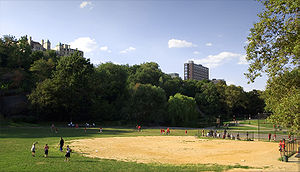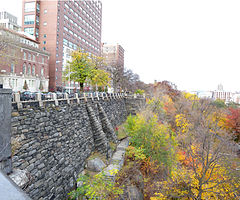- Morningside Park (New York City)
-
Morningside Park is a New York City public park in the northern portion of the New York City borough of Manhattan. The 30-acre (12 ha) area occupies 110th to 123rd Streets from Morningside Avenue to Morningside Drive at the border between Harlem and Morningside Heights. Its distinctive natural geography is a rugged cliff of Manhattan schist rock. The park came into existence as a cost-saving measure to avoid the expense of extending the street grid across difficult terrain.
Contents
History
The park was first proposed by the Central Park Commissioners in 1867. The city commissioned Frederick Law Olmsted and Calvert Vaux to produce a design for the park in 1873, but the plan was shelved during the economic depression following the Panic of 1873. In 1887 Olmsted and Vaux were asked to modify their original plan to accommodate changed conditions, such as the elevated railway station at 116th Street and Eighth Avenue, and construction of the park began.[1]
 Carl Schurz statue at Morningside Park.
Carl Schurz statue at Morningside Park.
Features
The park is one of several promoted by Andrew Haswell Green that owes much of its design to Frederick Law Olmsted and Calvert Vaux. Twentieth century additions include playgrounds, basketball courts, and softball diamonds. Other features include:
- Lafayette and Washington statue (1900) by Frédéric-Auguste Bartholdi, an exact replica of a statue in the Place des États-Unis, Paris
- Carl Schurz Memorial statue (1913) by Karl Bitter and Henry Bacon
- Seligman (Bear and Faun) fountain (1914) by Edgar Walter
- Dr. Thomas Kiel arboretum
- Waterfall and pond; residents and visitors include great blue herons, night herons, red-winged blackbirds, painted turtles, and mallard ducks
- Baseball diamond and basketball courts
Daffodil Project
Morningside Park is part of the New York City Daffodil Project, a 9-11 memorial. The thousands of daffodils draw visitors to the park in early spring.[2][3]
Controversy
Main article: Columbia University protests of 1968Morningside Park was the focus of the famous Columbia University protests of 1968. The university planned to build a gymnasium on the park as a joint project with the city. Protesters believed the planned separate east and west entrances amounted to an attempt to circumvent recent federal law that banned racially segregated facilities. The distinctive local geography and demographics would have opened one end of the gymnasium to African-American Harlem residents and opened the other end to the predominantly white university. University administration under Grayson Kirk denied that this reflected racial bias and stressed that greater park services would benefit the Harlem community. The university abandoned the plan after students occupied administration and classroom buildings and shut down the university for several weeks.
References
- Notes
- ^ Dolkart, Andrew S. (2001). Morningside Heights: A History of Its Architecture and Development, pp. 22-23. Columbia University Press. ISBN 023107851X.
- ^ "The Daffodil Project" (PDF). Friends of Morningside Park. 2006. http://www.nycgovparks.org/parks/M277/highlights/7804. Retrieved October 23, 2011.
- ^ Soman, Sandeep; Soufian, Shirin (October 25, 2005). "Interns Beautify Morningside Park". Columbia Spectator. http://www.columbiaspectator.com/2005/10/25/interns-beautify-morningside-park. Retrieved October 23, 2011.
- Further Reading
- The Strawberry Statement: Notes of a College Revolutionary by James Simon Kunen (Brandywine Press: 3rd edition May, 1995). ISBN 1-881089-52-5
- Up Against the Ivy Wall: A History of the Columbia Crisis by J. L. Avorn (Scribner: June, 1968). ISBN 0-689-70236-1
- Gray, Christopher (July 31, 2005). "An Oasis of Green, Reclaimed by City and Community". The New York Times. http://www.nytimes.com/2005/07/31/realestate/31scap.html.
External links
See also
Place des États-Unis
Coordinates: 40°48′22″N 73°57′31″W / 40.806225°N 73.95848°W
Categories:- Parks in Manhattan
- Harlem, New York
Wikimedia Foundation. 2010.



